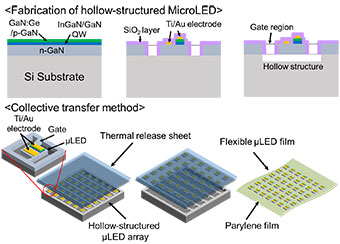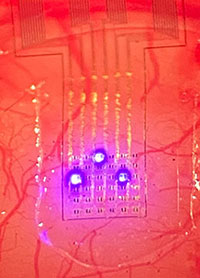
ここからコンテンツです。

Illuminating the brain with an ultra-thin, flexible, multipoint microLED array film
Development of a new optogenetic device that enables simultaneous optical stimulation at specific/multiple regions in the brainHiroto Sekiguchi
Researchers including Associate Professor Hiroto Sekiguchi in the Department of Electrical and Electronic Information Engineering at Toyohashi University of Technology, Associate Professor Noriaki Ohkawa in the Comprehensive Research Facilities for Advanced Medical Science at Dokkyo Medical University, and Assistant Professor Izumi Fukunaga in the Sensory and Behavioural Neuroscience Unit at Okinawa Institute of Science and Technology Graduate University, have developed a flexible, multipoint microLED array film. The film can be flexibly attached to cover the brain and can illuminate specific regions of the brain using microLEDs arranged along multiple points.
In recent years, optogenetics(Note 1) has enabled the manipulation of neural activity by light. This technique requires a light-emitting device, but until now, there has been no implantable optical device that can be attached to cover the entire tissue of the brain or other organs, illuminate only the target neurons, and manipulate their activity with light at will.
To implement this device, a thin, lightweight, and flexible body is required. It was thus necessary to establish a technology to precisely arrange an LED layer a couple of micrometers thick highly on an ultra-thin biocompatible film. This time the research group has established both (1) a technology to form a hollow structure of microLEDs with high density and in minute detail, and (2) a high-precision batch transfer technology using a thermal release sheet. With these technologies, it has also successfully developed an ultra-thin, lightweight multipoint microLED array film that maintains lighting performance even when the film is bent. The application of the developed device is expected to create a new area of neuroscience research aimed at comprehensively understanding the brain information that underpins how neural activity, behaviors, and disorders are linked.

Technology to form a hollow structure of microLED (Upper) MicroLED array batch transfer technology (Lower).
At present, attempts are being made to use light to manipulate the activity of various functional molecules inside an organism. In particular, optogenetics - a technique to activate neural activity with light by expressing photosensitive proteins that react to a specific color of light in neurons - has a high temporal resolution and has been utilized to elucidate brain function. However, to comprehensively elucidate the complex neural network created by neurons in the brain, it is necessary to employ light stimulation that will enable free manipulation of certain regions of neurons distributed across a wide range of the brain. The application of conventional optical fibers and microscopes is not sufficient to illuminate certain or multiple regions at the same time and also restricts the free movement of animals. Although this meant high hopes for the application of an implantable LED device, the size of commercial LEDs is as large as 200 µm with thickness of tens to one hundred micrometers, so that it cannot cover a wide range of the brain. As such, it was considered unsuitable as a device to stimulate specific neurons in the regions.

Given this, the research group sought to utilize a flexible film that is thin, lightweight, and bendable, and took the challenge of fabricating microscopic and ultra-thin microLEDs less than 100µm in size and a couple of micrometers in thickness and arranging them on multiple points. To achieve this, the group adopted the anisotropic wet etching method(Note 2) using potassium hydroxide to selectively remove the bottom LED layer, which led to the formation of a hollow structure of microLEDs that are arranged at high density. Since the LED layer is separated from the substrate by the formation of the hollow structure, only the LED layer is peeled off in a batch using a thermal release sheet, and the micro-LEDs are successfully arranged on the film without damaging either the micro-LEDs or the parylene film (Note 3). By applying this technique, the group has successfully fabricated a microLED array on the film. This microLED-mounted film maintains its lighting performance even when being bent. It has also been verified that bright blue light can be obtained and used in actual optogenetic experiments with the film adhered to the surface of a mouse's brain.

The multipoint microLED film developed through this study has potential broader applications in neuroscience and will facilitate the control of complex brain activity freely in the spatiotemporal aspects. The brain has diverse functionalities in various regions and serves to manipulate the whole body in a complex way. It is anticipated that this technology, when combined with measuring technology, will create a new area of neuroscience research aimed at comprehensively understanding the brain information that underpins how neural activities, behaviors, and disorders are linked. Furthermore, further development of light-sensitive functional molecules in vivo is expected to lead to the application of phototherapy technology using implanted devices in vivo, in which drugs can be applied to targeted areas at desired times by irradiating them with light.
The results of this research will be published online at Applied Physics Express on March 18, 2022 (8am GMT). In addition, this work was supported by the Precursory Research for Embryonic Science and Technology Agency (JPMJPR1885) of the Strategic Basic Research Programs in Japan Science and Technology Agency (JST), under the project title "Innovation of invasive LED devices for biological optical stimulation" in the research area " Development of optical control technologies and elucidation of biological mechanisms."
Glossary
- Note 1: Optogenetics
- Optogenetics is a technique to manipulate the activity of target neurons with light. This is achieved by gene transfer technology with which the illumination of light with specific wavelengths can express proteins that changes their activity. Channelrhodopsin-2, known as a typical protein, can introduce sodium ions into cells during neural activity when applying blue light and can artificially induce the activity of target neurons.
- Note 2: Anisotropic wet etching
- Anisotropic wet etching is a technique to selectively dissolve certain crystal orientations of semiconductors using chemicals. In this project, potassium hydroxide was used to selectively remove a certain crystal orientation of Si substrates.
- Note 3: Parylene film
- Parylene is the generic term for paraxylene-based polymers and is known as biocompatible material. The ultra-thin film can be formed by vapor deposition. It is applied as a coating material for biomedical devices such as pacemakers.
Reference
Hiroto Sekiguchi, Hayate Matsuhira, Ryota Kanda, Shuto Tada, Taiki Kitade, Masataka Tsutsumi, Atsushi Nishikawa, Alexander Loesing, Izumi Fukunaga, Susumu Setogawa, Noriaki Ohkawa (2022). Adhesionable flexible GaN-based microLED array film to brain surface for in vivo optogenetic stimulation, Applied Physics Express.
https://doi.org/10.35848/1882-0786/ac5ba3
薄くて曲げられる多点マイクロLEDアレイ極薄フィルムで脳に光照射
脳の特定部位や複数部位を同時に光照射できる新しい光遺伝学用デバイスを開発関口 寛人
豊橋技術科学大学 電気・電子情報工学系の関口寛人准教授と獨協医科大学 先端医科学統合研究施設 大川宜昭准教授、沖縄科学技術大学院大学 知覚と行動の神経科学ユニット 福永泉美准教授らは、脳を覆うように柔軟に取り付けができ、多点に配置したマイクロLEDで脳の特定部位を狙って光を照射できるフレキシブルフィルムを開発しました。
近年では、光遺伝学的手法(注1)を利用して、生体の外部から光のみを当てることで、神経細胞の活動を制御することが可能になっています。この手法では光を照射するデバイスが必要になりますが、脳などの組織全体を覆うように取り付けて、目的の神経細胞のみに光を当て、その活動を自在に光操作できる生体埋め込み型の光デバイスはありませんでした。
このデバイスの実現には、薄さと軽さ、柔軟性を持たせるために、厚さ数µmのLED層のみを、極薄の生体適合性フィルム上に高精度で配置する技術の確立が必要でした。今回本研究グループは、(1)高密度かつ微細にマイクロLEDの中空構造を形成する技術、(2)熱剥離シートの適用による精度の高い一括転写技術の双方を確立し、薄くて軽く、曲げても光を照射する性能が低下しない多点マイクロLEDアレイ極薄フィルムを開発することに成功しました。開発されたデバイスは、神経活動と行動や疾患との因果関係に裏打ちされた脳情報の包括的な理解を目指す、新しい神経科学研究の開拓への応用が期待されます。
現在、生体内で働く様々な機能分子の活性を光で制御する試みが進んでいます。その中でも、特定の色の光に反応する光感受性タンパク質を神経細胞に発現させることで神経活動を光で制御できる光遺伝学的手法は、時間分解能が高く、脳機能の理解に向けて活用されています。神経細胞が作る複雑な脳の神経ネットワークの包括的な理解に向けて、脳の広範囲に分布する特定の神経細胞の部位を自在に制御できる光刺激技術が求められていました。しかし、従来の光ファイバや顕微鏡を用いた方法では特定の部位や複数の部位を同時に光照射することは困難であり、自由行動中の動物への利用も限られていました。そのため、生体に埋め込むことのできるLEDデバイスの活用が期待されていましたが、市販のLEDのサイズは200µmと大きく、厚さも数十µm~100µmと厚いため、脳の広範囲を覆うことができず、部位上の特異的な神経細胞を光刺激できるデバイスとしての利用は不向きと考えられていました。
本研究グループは、薄くて軽くて曲げることができるフレキシブルフィルムの利用を目指し、その上にサイズが100µm以下と小さく厚さ数µmとなる極微薄のマイクロLEDの多点配置を試みました。そのために、水酸化カリウム溶液による異方性ウェットエッチング法(注2)を適用することで、LED層下部を選択的に除去し、高密度に配置されたマイクロLED中空構造を形成しました。中空構造の形成によりLED層が基板から分離されため,熱剥離シートを用いて一括でLED層のみを剥がし、マイクロLEDおよび生体適合フィルムであるパリレンフィルム(注3)のどちらも損傷することなく、フィルム上にマイクロLEDを配列させることに成功しました。この実装マイクロLEDフィルムは曲げても光照射特性が劣化することなく、実際にマウスの脳表面に密着して光遺伝学実験に利用可能な明るい青色発光が得られることが実証されました。
本研究で開発された脳の広範囲に適用可能な多点マイクロLEDフィルムは、光によって時空間的に自在に複雑な脳活動の制御を実現するものです。脳は様々な領域がそれぞれ異なる機能性を持つことで複雑に全身のコントロールを司っています。今後計測技術と組み合わせることで因果関係に裏打ちされた脳活動と行動や疾患との包括的な理解を目指す、新しい神経科学研究の開拓への適用が期待されます。さらに、光感受性の生体内機能分子の開発がさらに進むことによって、光を照射することにより、薬剤を狙った部位で好きなタイミングに効かせることができる、生体埋め込みデバイスによる光治療技術へと応用されることが期待できます。
本研究成果は、2022年3月18日(GMT:8時)に「Applied Physics Express」にオンライン掲載されました。また、本研究は、科学技術振興機構(JST)戦略的創造研究推進事業 さきがけ「生命機能メカニズム解明のための光操作技術」研究領域 研究課題名「生体光刺激のための侵襲型LEDデバイスの革新」(JPMJPR1885)からの支援により行われました。
<用語解説>
- 注1:光遺伝学的手法
- 遺伝子導入によって特定の波長の光を当てると活性が変化するタンパク質を発現させることで、狙った神経細胞の活動を光で制御する手法である。代表的なタンパク質として知られるチャネルロドプシン2は、青色の光によって神経活動時のナトリウムイオンを細胞内に流入でき、人為的に標的の神経細胞の神経活動を誘発できる。
- 注2:異方性ウェットエッチング
- 化学薬品を用いて半導体結晶のある特定方向だけを選択的に溶解する技術である。本研究では、水酸化カリウム溶液を用いることでSi基板の特定の結晶方位を選択的に削られた。
- 注3:パリレンフィルム
- パラキシリレン系ポリマーの総称であり、生体適合性材料として知られる。蒸着法により成膜することで極薄のフィルムを形成することができる。ペースメーカーを始めとする生体医療機器のコーティング材料として活用されている。
Researcher Profile

| Name | Hiroto Sekiguchi |
|---|---|
| Affiliation | Department of Electrical and Electronic Information Engineering |
| Title | Associate Professor |
| Fields of Research | Light-Emitting Device / Semiconductor Engineering |
ここでコンテンツ終わりです。
